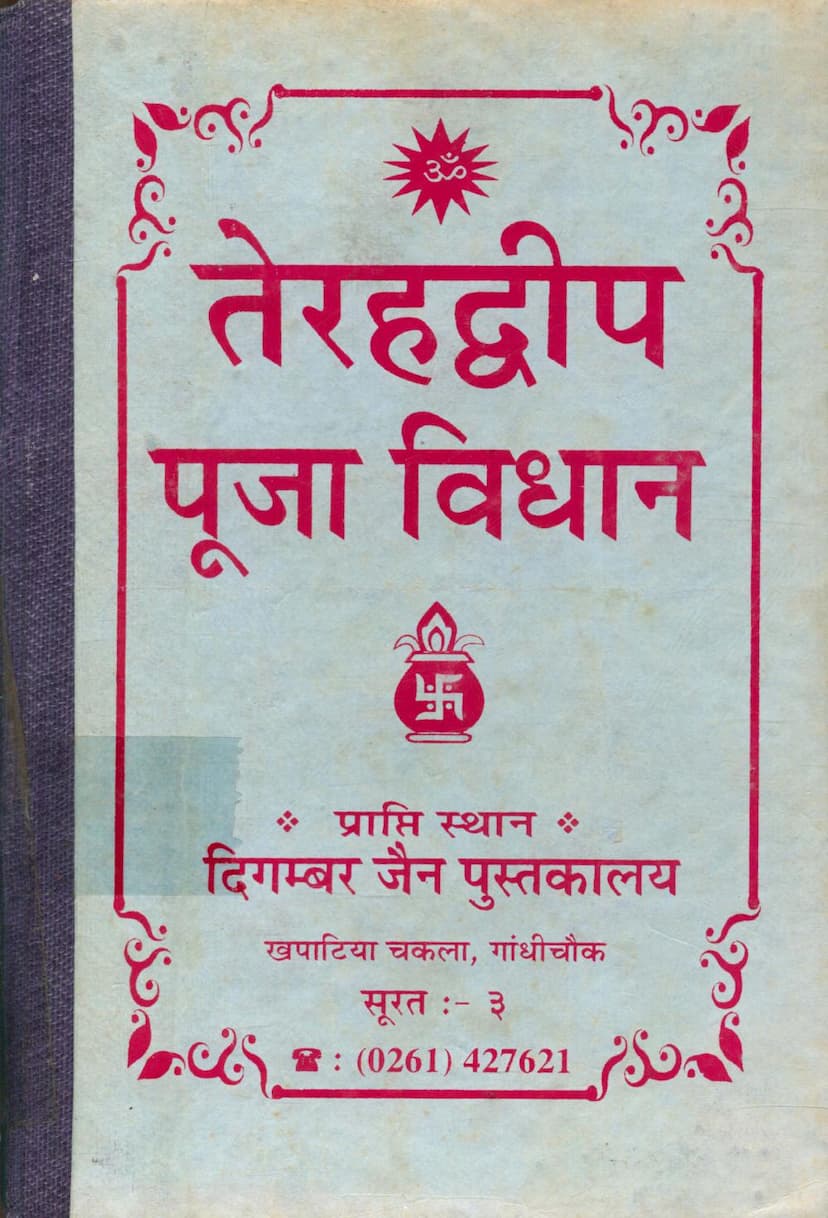Terah Dwip Puja Vidhan
Added to library: September 2, 2025

Summary
This document is a Jain text titled "Terah Dwip Puja Vidhan" (Process of Worship for Thirteen Islands), authored by Mulchand Kisandas Kapadia and published by Digambar Jain Pustakalay. The catalog link is provided as https://jainqq.org/explore/032847/1. It is intended for private and personal use only.
The text is a compilation of worship rituals for 458 Jinmandirs (temples of Jinas) located across the thirteen islands described in Jain cosmology.
Key aspects and summary of the document:
- Author and Publisher: The compiler and publisher is Mulchand Kisandas Kapadia of Digambar Jain Pustakalay, Surat. The typesetting and printing were done by Shailesh Dahyabhai Kapadia.
- Origin of the Work: The original composition of the "Terah Dwip Puja Vidhan" is attributed to Kavi Shrilalji (also known as Laljit or 'Lal') from Bhelupur, Kashi, who lived in the 18th century. He was a scholar of prosody (Chhand Shastra).
- Historical Context: The preface mentions the transition from handwritten Jain scriptures to printed ones about 80 years prior, noting the significant opposition faced but highlighting the courage of Lala Jainilal Jain of Devband in publishing several texts, including this one, around 1906. The book has seen multiple reprints, with this being the eighth edition.
- Kavi Shrilalji's Background: The preface provides some details about Kavi Shrilalji. He had previously composed the "Shri Samavsaran Puja Vidhan." His lineage is traced to Sawaipur, where a Khandelwal Shravak named Pandit Todermal lived. Shravak Banarasidas, who settled in Sakarabad, had a son named Lalji, who was a friend of the poet Lalji. The poet was encouraged by Subhkharai to compose the Samavsaran Puja Vidhan, which he completed in 1777 Vikram Samvat (AD 1720-1721). Later, around 1819 AD (Vikram Samvat 1877), he composed the "Shri Terahdwip Puja Path Vidhan" in Bhelupur, Kashi, which was initially handwritten.
- Literary Merit: Kavi Shrilalji is praised for his profound knowledge of prosody, evident in the composition of the worship rituals in numerous poetic meters.
- Content and Purpose: The "Terah Dwip Puja Vidhan" contains approximately 62 types of pujas (worship rituals) in various meters, dedicated to 458 Jin Mandirs across the thirteen islands. The text also provides instructions for the "mandana" (decoration or altar setup) for these pujas, with specific details from pages 7 to 13, created by the poet himself. A general diagram for the decoration is also included.
- Accessibility: The preface notes that this comprehensive puja is extensive, but even those unable to perform the full ritual can benefit from studying the "Vidhan" to gain a complete understanding of the thirteen islands.
- Practical Information: The publication also offers to provide a cloth "mandana" (decoration) for those who cannot create one with rice, available for ₹750.
- Structure of the Puja: The book includes a detailed "Pujan Suchi" (List of Worships) outlining 63 distinct pujas, covering the worship of various divine entities and specific locations within the Jain cosmology, often involving elaborate descriptions of deities, mountains, trees, and celestial beings. It starts with Mangalacharan (auspicious invocation) and details the worship procedures for various locations within the thirteen islands, such as Sudarshan Meru, Jambu Vriksha, Shalmal Vriksha, Rupachal, Shatkulachal, Vijay Meru, Achal Meru, Vidyunmali Meru, Nandi Ishwar Dwip, Kundal Dwip, and Ruchik Dwip.
- Detailed Puja Descriptions: The subsequent pages provide the actual puja procedures in Hindi poetry, often employing various meters like Doha, Savaiya, Padadi, Adill, Sundari, Mad Avlipt, and Kusum Lata. The pujas include the invocation (Ahvanan), establishment (Sthapan), and worship with eight types of offerings (Asht Dravya) for various deities and Jinas situated in different locations within the Jain universe. The text also includes Jaymalas (victory garlands) and blessings.
In essence, "Terah Dwip Puja Vidhan" is a significant Jain devotional text that meticulously details the worship practices for numerous sacred temples across the various realms of Jain cosmology, compiled with historical and literary insights by Kavi Shrilalji and later published by Mulchand Kisandas Kapadia.